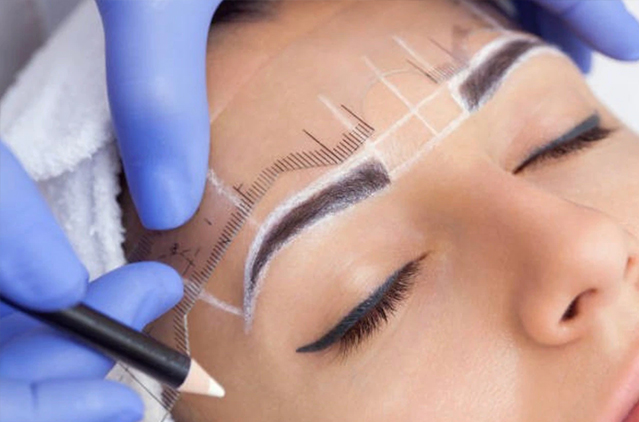
To look beautiful is a human desire. It enhances self-esteem, confidence, social admiration, and social acceptance. Busy schedules, stressful lifestyles, hormonal changes, aging, and certain medical conditions cause problems such as hair loss and thinning of eyebrows. This leads to cosmetic issues, which can lower the confidence and self-esteem of an individual. To overcome these challenges, semi-permanent makeover techniques are becoming more popular. Microblading and Micropigmentation are popular and advanced procedures used as semi-permanent makeovers. These cosmetic procedures give permanent and long-term results with minimum side effects. Initially, these procedures may look similar; however, they are quite different. In this article, read on to understand the difference in detail.
Microblading
It is a non-invasive (less complicated) procedure that is performed by using a fine needle pen. Small incisions(cuts) are made into the skin with the help of a handheld blade. This deposits the pigment into the superficial (upper) layers. It is used to enhance the eyebrows in people whose eyebrows may have thinned out due to the following:
- Ageing
- Hereditary
- Medical conditions such as Madarosis
- Skin infections
- Hormonal changes
- Stress
Loss of eyebrows creates cosmetic concerns which can be effectively treated.
The pigment penetrates the skin from 0.08mm to 0.15mm in depth. The tip of the needle is so fine that the hair strokes which are created look like natural hair. This procedure is less painful; however, pain is further reduced by using a numbing cream.
Microblading gives a very natural look to the eyebrows. It is semi-permanent, and the results last for upto 12 to 18 months, depending on the skin type, lifestyle modifications (sun exposure, exfoliants, .etc), and post-procedure homecare.
Benefits of Microblading
- It is a less painful procedure.
- It gives fuller and more natural-looking eyebrows.
- It is relatively affordable.
- It is superficially done; hence there are less side effects.
- Post microblading procedure, the risk of infection and allergic reactions is less.
Micropigmentation
It is a non-invasive, semi permanent makeover treatment. It is performed to enhance the scalp, eyebrows, eyelashes, and lips (to correct the colour). It is also called cosmetic tattooing, and done using a digital machine instead of a manual blade. It uses micro and nano needles to create strokes. The pigment penetrates the skin in a much deeper (dermis) layer, to a depth of 1mm. Micropigmentation is used for the following purposes :
- To minimise the appearance of scars.
- To replace hair loss in case of thinning of the hair or baldness (as seen in alopecia).
- To enhance the appearance (shape, contour) of eyebrows.
- To replace the loss of eyebrows due to ageing and other medical conditions.
- To create an areola (the pigmented area around the nipple) following breast surgery.
- As a semi-permanent makeup procedure (eyeliner, lip colour).
Benefits of Micropigmentation
What is the difference between microblading and micropigmentation?
- The results last for upto 3 years, longer than microblading.
- It is used for other areas as well such as scalp, eyelashes, and lips, and not just confined to eyebrows like Microblading.
- Replaces eyebrows lost due to treatments such as chemotherapy.
Microblading and Micropigmentation, are two most popular makeover procedures which look similar, yet have many differences with respect to:
- Procedure: The outermost layer of your skin is called the epidermis, followed by the middle layer of your skin which is called the dermis. Microblading uses a fine needle pen to make incisions and deliver the pigment in the superficial (upper) layer of the skin (depth 0.08-0.15mm). At this depth, the pigment is deposited into the border between the epidermis and the dermis. Micropigmentation uses a digital machine instead of a manual blade and delivers the pigment into the deep layers of the skin (depth of 1mm). At this depth, the pigment is deposited into the middle layer of the skin- the dermis.
- Colour: The colours of the pigments used in Microblading appear much more natural, as compared to the pigments used in Micropigmentation. The pigment is selected based on the patient’s skin tone, complexion, and hair colour.
- Results: Microblading shows results which lasts for 12-18 months, and slowly begins to fade. In Micropigmentation, the results last for 1-3 years. Hence, Micropigmentation provides long-term skin pigmentation with deeper penetration. Although the pigment never washes off, it gradually fades over time.
- Side Effects: Microblading is generally a safe procedure, but it can sometimes cause itching and mild pain. Micropigmentation causes temporary side effects like: itching, pain, swelling, bruising, scabbing, tenderness and heaviness. There may be other complications post Micropigmentation such as: keloids (these are scars which form when the skin is irritated or injured), granulomas (nodules around the particles of the pigment used), and severe eyelid injury (when the procedure is done around the eyes).
Post-Procedure Care:
In Microblading the post-procedure care should be as follows-
- Do not apply water or cream on the treated area four days post-procedure.
- Do not rub or scratch the treated area, especially during the healing and peeling phase. This will lead to pigment loss.
- Avoid direct exposure to the sun for three to four weeks post-procedure.
After Micropigmentation, ensure the following-
- Do not exercise for at least 24 hours.
- Avoid exposing the treated area to excessive moisture or humidity (facials, swimming, saunas).
- Avoid touching the treated area repeatedly.
- Do not rub or scratch the treated area post-procedure which causes pigment loss.
- Avoid direct exposure to the sun for three to four weeks after the procedure.
Consultation and Patch Test
Microblading and Micropigmentation treatments require an experienced dermatologist who has good knowledge about the procedure, its benefits and side effects. A patch test (the pigment or solution is applied to a part of the body and left for sometime to check the response) is important before starting the procedure to avoid any unnecessary skin reactions.
Making a choice between the two
Both Microblading and Micropigmentation treatment processes take 2 hours to complete.
- In Microblading, pigment is deposited into the superficial layer of the skin, hence this is less painful when compared to Micropigmentation.
- Microblading enhances only the eyebrows, whereas Micropigmentation helps enhance the eyebrows, eyelids, lips and scalp (in case of hair loss seen in alopecia).
- Allergic reactions are comparatively less in Microblading than in Micropigmentation.
- Microblading gives a more natural look.
- The results last longer in Micropigmentation than in Microblading.
Book your appointment today with Kosmoderma or walk in at our centre to get started on your visual transformation.



